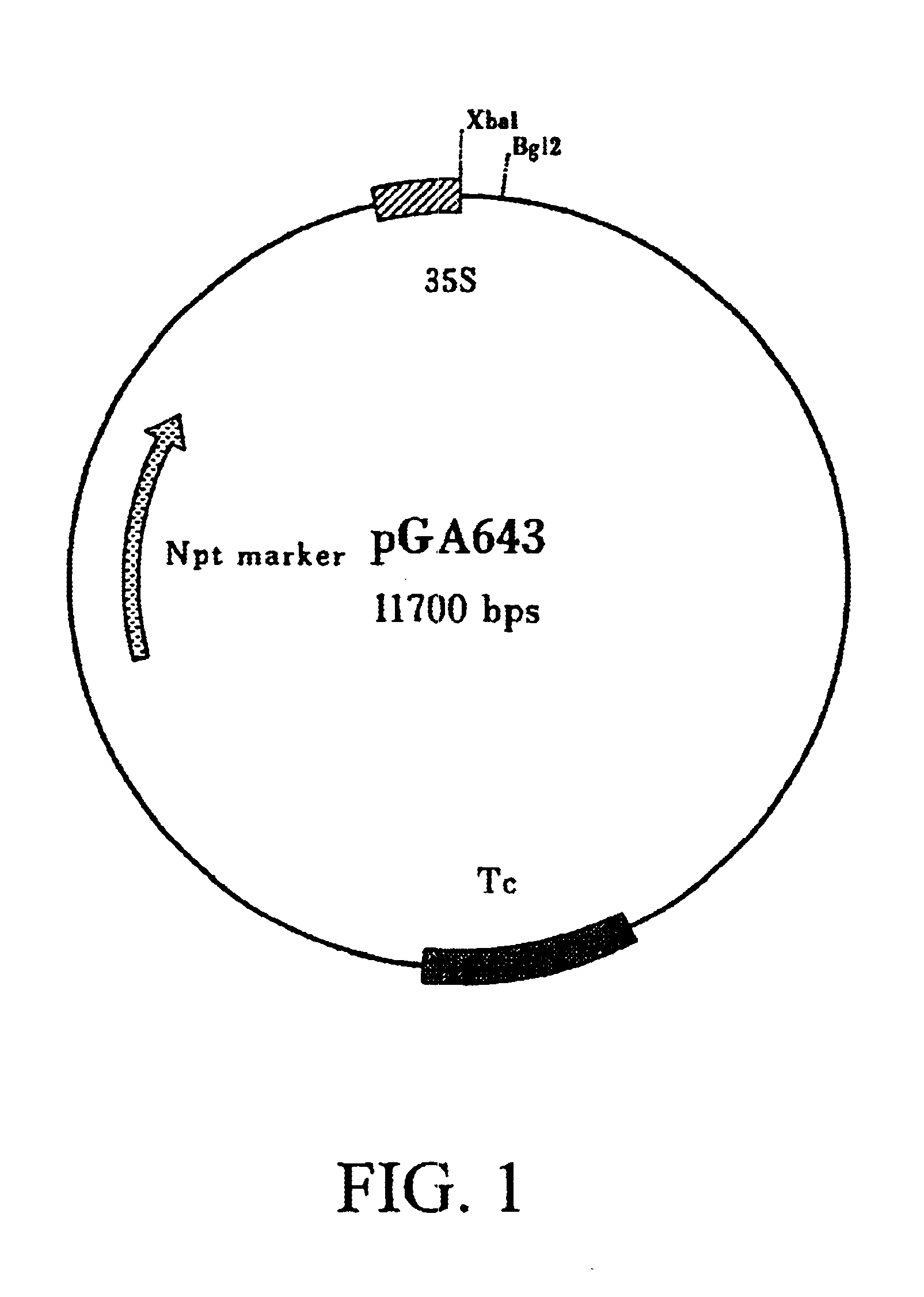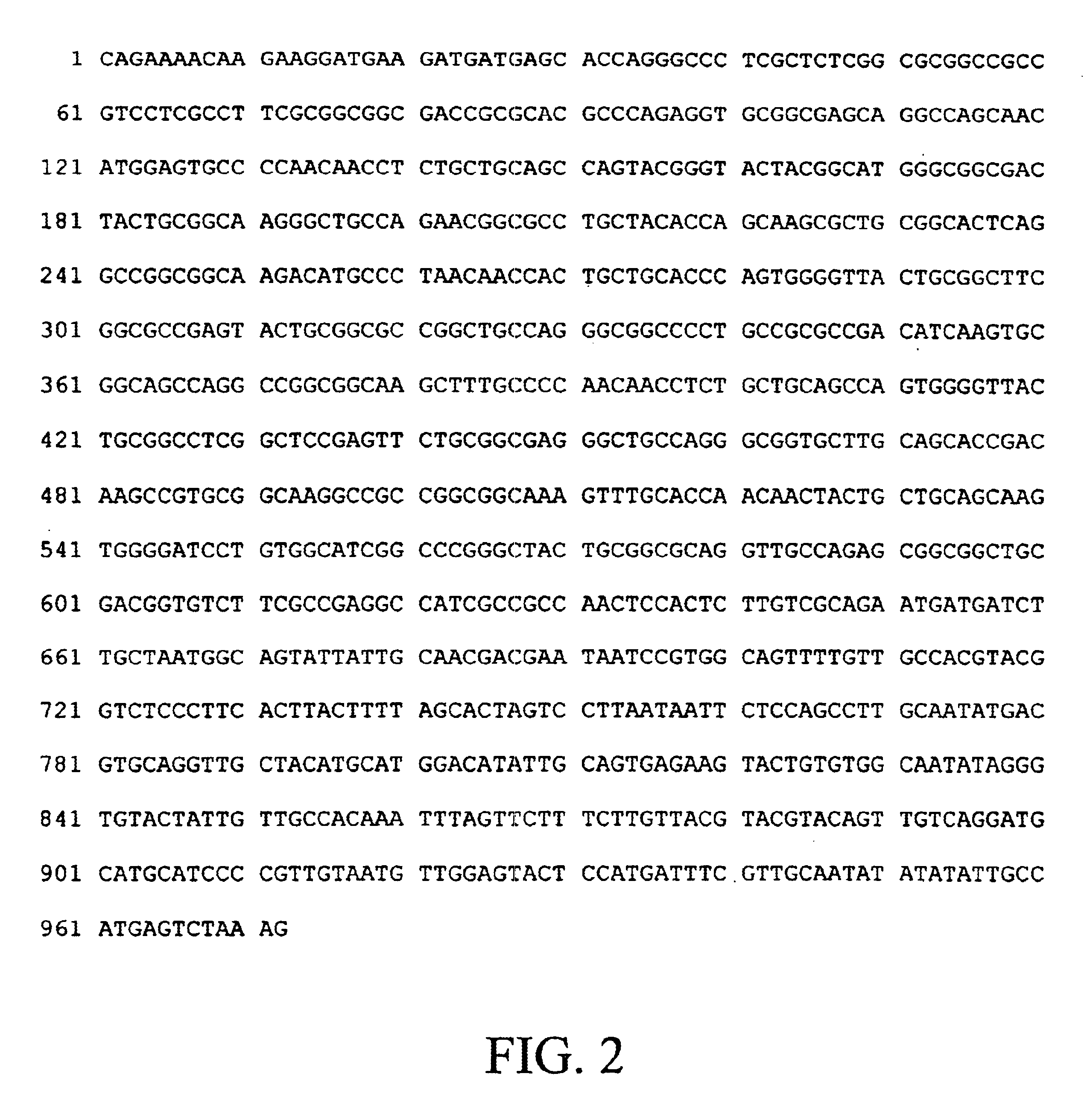Cotton cells, plants, and seeds genetically engineered to express insecticidal and fungicidal chitin binding proteins (lectins)
a technology of lectin and binding protein, which is applied in the field of genetically engineered lectins, which can solve the problems of inability to readily treat root-associated pathogens with such preparations, inability to use lectins in controlling many, and inability to provide biochemical characterization
- Summary
- Abstract
- Description
- Claims
- Application Information
AI Technical Summary
Problems solved by technology
Method used
Image
Examples
example 2
Cotten Regeneration
The establishment and maintenance of cotton embryogenic suspension cultures was as described in Rangan et al. (U.S. Pat. No. 5,244,802; incorporated herein by reference), as further modified in Rajasekaran et al., 1996 (incorporated by reference). For convenience, the cotton line B1654 was used. Many other upland or Pima cotton varieties will work equally well, and those skilled in the art would make their variety selection on the basis of the needs of their program.
Seeds were surface sterilized by first treating with 70% ethanol for 3 min, followed by a 20 min treatment with a 20% CLOROX solution (1% available chlorine) containing 0.01% of the surfactant TWEEN-20. Seedlings were grown under 16 h light (40-60 .mu.E m.sup.-2 s.sup.-1) and 8 h dark at 26.+-.2.degree. C. on agar-solidified (TC Agar, Hazleton Biologics, Lenexa, Kans.) White's medium (Singh and Krikorian, 1981) containing 1 mg / l kinetin. Embryogenic callus cultures were first established from seedling ...
example 3
Biolistic Transformation of Embryogenic Cotton Cultures
The three plasmids (barley lectin coding region in pGA643; hevein coding region in pGA643; and nettle lectin coding region in pGA643) were used to coat 1.0 .mu.M gold particles, and then projected into embryogenic cotton suspension cell cultures using an improved helium-driven biolistic device (PDS 1000 / He; BioRad). Briefly, 50 .mu.l of a gold micro-carrier suspension (1.mu. gold particles) in water was used. In an 1.5 ml micro-centrifuge tube, under continuous vortexing, the following were added in order: 5 .mu.l DNA (1 .mu.g / .mu.l), 50 .mu.l of 2.5M CaCl.sub.2 and 20 .mu.l of 0.1M spermidine (free base, tissue culture grade). Vortexing was continued for 3 minutes, the micro-carriers were spun down at 10,000 rpm for 10 seconds, and as much of the supernatant was removed as possible. The micro-carriers were washed with 250 .mu.l of 100% ethanol (HPLC or spectrophotometric grade) by vortexing briefly, followed by centrifugation a...
example 4
Agrobacterium Transformation With Lectin Genes
The three binary vector plasmids (barley lectin coding region in pGA643; hevein coding region in pGA643; and nettle lectin coding region in pGA643) were mobilized into the binary A. tumefaciens host strain LBA4404 by triparental mating as previously described. Transformation of cotton primary explants can be accomplished by a number of approaches (Firoozabady et al., 1987; Umbeck et al., 1987; Rangan, U.S. Pat. No. 5,244,802). For convenience, the method of Rangan, U.S. Pat. No. 5,244,802, as modified by Rajasekaran et al., 1996, is briefly described.
Agrobacterium cultures for transformation experiments were initiated in 50 ml of YEB liquid medium using frozen glycerol stocks (500 .mu.l) as inoculum. These cultures were grown overnight for about 18 h at 26.+-.2.degree. C. on a gyratory shaker. The optical density (A600) values were adjusted to 0.6-0.8 in liquid MS medium prior to use.
Cotyledon (1 cm.sup.2) explants for Agrobacterium tran...
PUM
| Property | Measurement | Unit |
|---|---|---|
| rupture pressure | aaaaa | aaaaa |
| distance | aaaaa | aaaaa |
| distance | aaaaa | aaaaa |
Abstract
Description
Claims
Application Information
 Login to View More
Login to View More - R&D
- Intellectual Property
- Life Sciences
- Materials
- Tech Scout
- Unparalleled Data Quality
- Higher Quality Content
- 60% Fewer Hallucinations
Browse by: Latest US Patents, China's latest patents, Technical Efficacy Thesaurus, Application Domain, Technology Topic, Popular Technical Reports.
© 2025 PatSnap. All rights reserved.Legal|Privacy policy|Modern Slavery Act Transparency Statement|Sitemap|About US| Contact US: help@patsnap.com



